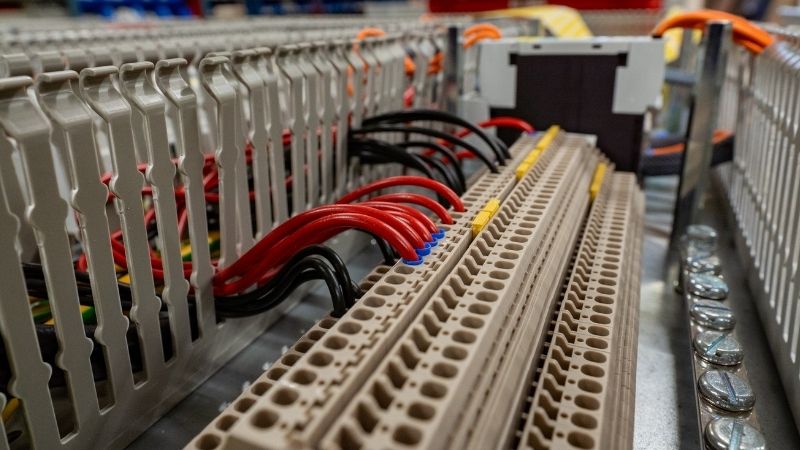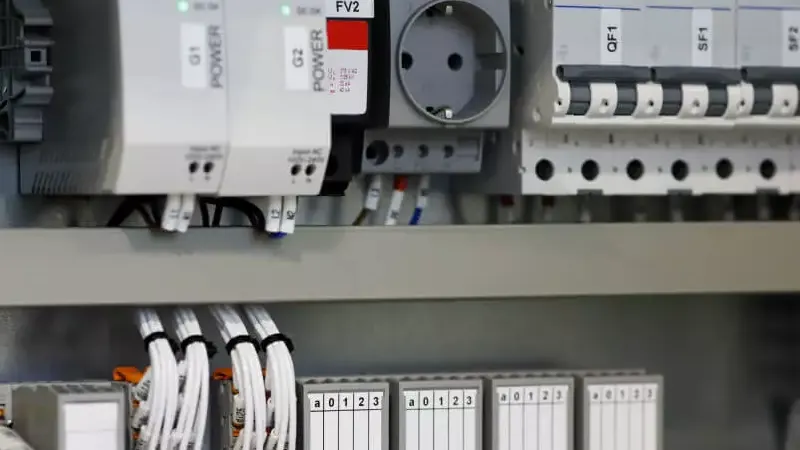Guia para E/S analógicas de PLC para engenheiros de automação
Se você é um engenheiro de automação, este artigo lhe dará o conhecimento básico necessário para trabalhar com confiança com sinais analógicos em um CLP ambiente. Ao final desta leitura, você terá um melhor entendimento de tensão e corrente, como interagir adequadamente com entradas analógicas e como otimizar seus sistemas para melhor desempenho.
Então, vamos explorar como você pode melhorar seu fluxo de trabalho e eficiência dominando os sistemas de entrada e saída analógicos do PLC.
Índice
O que é entrada analógica em sistemas PLC?
A entrada analógica é o processo de recebimento de sinais contínuos (geralmente tensão ou corrente) de dispositivos externos como sensores, que podem representar variáveis do mundo real, como temperatura, pressão ou nível. Em um sistema PLC, essas entradas são essenciais para monitorar e controlar processos industriais.
O módulo de entrada analógica do CLP é responsável por converter os sinais analógicos de entrada em dados digitais que o CLP pode processar.
Tipos de sinais analógicos
As entradas analógicas podem estar na forma de tensão ou corrente. Os níveis de tensão comuns incluem 0-5 V, 0-10 V ou 4-20 mA, enquanto os sinais de corrente geralmente variam de 4-20 mA. Esses sinais variam continuamente, ao contrário dos sinais digitais que estão ligados ou desligados. A conversão adequada desses sinais é crucial para o desempenho preciso do sistema.
Componentes-chave
O cartão de entrada no PLC é tipicamente projetado para lidar com um tipo específico de entrada analógica (tensão ou corrente). O módulo de entrada analógica desempenha um papel crítico ao converter o sinal em uma forma que o sistema PLC pode interpretar. Essa conversão permite que o sistema de automação tome decisões orientadas por dados com base em entradas do mundo real.
2. Como a tensão e a corrente afetam as entradas analógicas do CLP?
Entender como a tensão e a corrente interagem com seu sistema PLC é fundamental. Os sinais de tensão e corrente são usados para se comunicar com vários sensores, fornecendo dados de entrada que podem controlar operações como velocidade, temperatura e pressão.
Mas por que a tensão e a corrente são críticas e como elas influenciam a operação do seu sistema de entrada analógica do PLC?
O Impacto da Voltagem
Sinais de tensão são tipicamente usados em situações onde a medição de uma quantidade física é necessária. Por exemplo, sensores de temperatura (como RTDs e termopares) frequentemente produzem sinais de tensão.
Esses sensores enviam dados como uma faixa de tensões (por exemplo, 0-5 V, 0-10 V), que devem ser interpretados com precisão pela entrada do CLP para garantir o controle correto do processo.
O papel da corrente
Por outro lado, sinais de corrente (tipicamente 4-20 mA) são mais robustos em ambientes industriais ruidosos. A corrente tende a ser menos suscetível a quedas de tensão em longas distâncias, tornando-a ideal para aplicações onde a transmissão precisa de dados é crítica.
Por exemplo, ao trabalhar com sensores de pressão ou medidores de vazão, os sinais de corrente fornecem dados confiáveis para o sistema PLC processar.
Qual é o papel dos sensores em sistemas de entrada e saída analógicos?
Sensores são a espinha dorsal dos sistemas analógicos de entrada e saída. Eles reúnem dados do mundo real e os convertem em um sinal que o PLC pode entender. Sensores como sensores de temperatura, células de carga e pressostatos são integrais para capturar dados ambientais que os sistemas de automação precisam para funcionar.
Tipos de sensores usados em sistemas PLC
Tipos comuns de sensores analógicos incluem RTDs, termopares e células de carga, cada um dos quais fornece um tipo exclusivo de sinal para o PLC. Por exemplo, RTDs produzem um valor de resistência que pode ser convertido em um sinal de tensão para entrada analógica do PLC, enquanto células de carga fornecem medições de strain gauge convertidas em um sinal analógico.
Desafios com Sensores
Ao trabalhar com sensores analógicos, é preciso garantir que o sensor esteja calibrado corretamente para fornecer leituras precisas. A fiação e a blindagem também são importantes para reduzir ruídos e interferências, que podem afetar a integridade dos sinais analógicos enviados ao sistema PLC.
Como solucionar problemas de entrada analógica em sistemas PLC?
Em um ambiente de automação, problemas de entrada analógica podem ser causados por uma variedade de fatores, como fiação ruim, degradação de sinal ou problemas com o módulo de entrada analógica do PLC. Solucionar esses problemas de forma eficaz é essencial para garantir o desempenho ideal do sistema.
Etapas comuns de solução de problemas
- Verifique as conexões da fiação: Fiação solta ou incorreta pode levar à perda de sinal ou leituras incorretas. Certifique-se de que todas as conexões estejam seguras e devidamente blindadas.
- Verificar a escala do sinal: se a saída do sinal do sensor não corresponder ao intervalo esperado, pode ser necessário dimensionar a entrada nas configurações do PLC.
- Monitore a integridade do sinal: use um voltímetro ou osciloscópio para verificar se a entrada analógica corresponde aos valores esperados. Problemas com quedas de tensão ou vazamento de corrente podem causar leituras errôneas.
Ferramentas avançadas de solução de problemas
Para problemas mais complexos, engenheiros de automação podem usar ferramentas avançadas de diagnóstico, como conversores de sinal ou conversores analógico-digitais (ADC) para identificar problemas no sistema de entrada analógica do PLC. Essas ferramentas podem ajudar a identificar problemas relacionados à calibração do sinal de tensão ou corrente.
Quais são as melhores práticas para dimensionar entradas analógicas em automação?
Ao lidar com sistemas de automação de larga escala, dimensionar entradas analógicas de forma eficaz é crucial. Não importa se você está gerenciando vários sensores ou trabalhando com equipamentos de alta precisão, o dimensionamento adequado garante que seu PLC possa lidar com um grande número de entradas sem sacrificar o desempenho.
Dicas para dimensionar entradas analógicas
- Use vários módulos de entrada: Ao lidar com um grande número de entradas analógicas, geralmente é melhor usar vários módulos de entrada PLC. Isso permite uma melhor distribuição de carga e garante que cada módulo de entrada analógica não fique sobrecarregado.
- Use Condicionamento de Sinal: Técnicas de condicionamento de sinal, como divisores de tensão e amplificadores, ajudam a dimensionar e ajustar sinais para processamento preciso. Isso é especialmente útil ao lidar com sinais de baixa tensão.
- Considere a resistência de entrada: Diferentes tipos de módulos de entrada analógicos têm resistência de entrada variável. Garantir que seu sistema PLC seja compatível com a resistência do seu sensor é essencial para garantir leituras precisas.
Perguntas frequentes
Qual é a diferença entre tensão e corrente em entradas analógicas?
Sinais de tensão são medições contínuas normalmente usadas para sensores como termopares, enquanto sinais de corrente são menos afetados pela distância e são ideais para sensores como pressostatos ou medidores de vazão.
Como calibro um módulo de entrada analógica PLC?
A calibração geralmente envolve o ajuste da escala de entrada na configuração do PLC para corresponder ao intervalo esperado do sensor ou transmissor conectado.
Por que meu sinal analógico está flutuando?
Flutuações podem ser causadas por vários fatores, incluindo conexões soltas, interferência ou blindagem inadequada da fiação. Sempre garanta aterramento e blindagem adequados em sua fiação.
Como dimensionar um sinal de entrada de corrente de 4-20 mA?
O dimensionamento de uma entrada de corrente de 4-20 mA envolve a conversão dos valores de corrente em uma faixa de variável de processo correspondente, geralmente usando um condicionador de sinal ou ajustando o dimensionamento no sistema PLC.
Potencialize seus projetos com PLC Omron, Mitsubishi, Schneider novos e originais – em estoque, prontos agora!
Conclusão
- Sinais analógicos de entrada e saída são cruciais na automação de processos industriais e vêm em duas formas principais: tensão e corrente.
- A calibração e o condicionamento de sinal adequados são essenciais para uma transferência precisa de dados entre os sensores e o sistema PLC.
- A solução de problemas de entrada analógica envolve verificar erros de fiação, verificar a integridade do sinal e garantir o dimensionamento correto.
- Dimensionar entradas analógicas de forma eficiente em grandes sistemas é essencial para lidar com múltiplos sensores e evitar sobrecarga.
Ao entender os conceitos fundamentais das entradas e saídas analógicas do CLP, você pode melhorar a confiabilidade e a precisão dos seus sistemas de automação, aumentando a eficiência operacional em seus projetos.
Procurando por PLCs novos e originais para seus projetos? Na Kwoco, estocamos os PLCs mais recentes das principais marcas como Omron, Mitsubishi, e Schneider. Compre com confiança — envio rápido, qualidade garantida! Compre agora
Contate-nos
Basta preencher seu nome, endereço de e-mail e uma breve descrição de sua consulta neste formulário. Entraremos em contato com você em até 24 horas.
Você também pode achar esses tópicos interessantes

O que é um VFD? – Como usar um em aplicações
Os Variable Frequency Drives (VFDs) estão transformando o cenário da automação industrial ao fornecer controle incomparável sobre a velocidade do motor e a eficiência energética. Neste guia abrangente, vamos nos aprofundar no que é um VFD, como os VFDs funcionam e como usar um em suas aplicações para obter desempenho e economia de energia ideais.

10 códigos comuns de alarme de servo drive Omron explicados
Como engenheiro na Kwoco com anos de experiência em automação industrial, trabalhei extensivamente com servo drives Omron. Ao longo dos anos, encontrei vários códigos de alarme que podem interromper as operações se não forem resolvidos imediatamente. Entender esses códigos é crucial para manter operações tranquilas e minimizar o tempo de inatividade.

O que é PLC e por que isso é importante para o seu negócio?
O que é PLC e por que ele é importante para o seu negócio? Sentindo-se sobrecarregado pelas constantes mudanças na automação industrial







